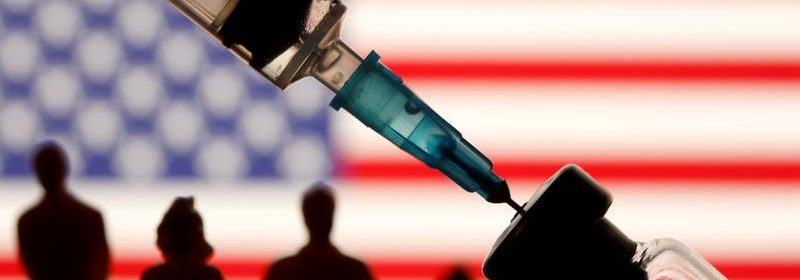With vaccinations rising, U.S. economy remains in the waiting room

WASHINGTON (Reuters) – U.S. policymakers are touting the gradual rise in the number of people who have received a coronavirus vaccination as the beginning of the end of the economy’s fight with the pandemic, but real-time data suggests the awaited rebound is still at the starting line.
The worst of the economic pain triggered by the virus may well have passed. Since the current surge in infections began last fall, measures of hiring at small businesses and workplaces across a variety of industries have remained depressed. They have stopped falling, however.
Daily data on restaurant seatings from OpenTable here and on airline passengers screened by the Transportation Security Administration have leveled off recently at about 40% below year-ago levels.
Graphic: The retail recovery in real time
Weekly filings for unemployment insurance still show the deep dislocation felt by workers in an economy roughly 9 million jobs short of where it was a year ago. The Labor Department reported on Thursday that 847,000 people filed new unemployment insurance claims for the week ending Jan. 23. The number collecting unemployment insurance benefits from the patchwork of state and emergency federal programs jumped by more than 2.2 million to 18.2 million in the week ending Jan. 9.
But even that bit of data held promise. The rise in the number of people collecting payments was driven by the use of pandemic emergency programs recently extended by Congress, meaning workers who might otherwise have been left without help were getting a renewed lifeline.
“It is as if the fire department is arriving just as the fire really gets going … and it may have maximum impact,” as that money will likely be spent quickly, said Nathan Sheets, chief economist at PGIM Fixed Income.
The combination of those renewed benefits beginning to flow to the unemployed, one-time checks going out to most U.S. residents, and a bulge of savings already tucked away by households could make for a potent rebound once the effects of the vaccine are more broadly felt, said Gregory Daco, chief U.S. economist at Oxford here Economics.
Graphic: Oxford Economics Recovery Index
The firm’s recovery index jumped 2 percentage points last week as the outlook for the country’s health crisis improved, the largest one-week improvement since June. The weekly average pace of infections has fallen to around 170,000 from a peak of more than 250,000 two weeks ago.
Graphic: Share of U.S. GDP and infection rates
With an estimated $1.6 trillion in extra savings stashed away by families limited in their ability to spend during the pandemic, “the rocket is fueled up and ready for launch once health conditions improve,” Daco said.
A recent survey by Yelp concluded that consumers may indeed have an itchy trigger finger: After it was announced in December that some of the vaccines were effective, activity related to wedding planning jumped 22% on the online review site.
It may take time for those plans to get realized in full, however, as households assess what a safe return to normal life might look like.
A recent survey by the Conference Board found nearly two-thirds of respondents said they did not expect to take a vacation for at least six more months. In a recent Harris poll, 30% of respondents said they would not “feel safe” eating indoors at a restaurant until “the country reaches herd immunity” – the point at which the virus cannot spread effectively because so many people are immune.
Immunologists differ on the level of immunity required to reach that goal, but it is high, and the U.S. vaccination program has stumbled out of the gates. More than a month after the first vaccinations began, only 24.6 million of the country’s 330 million residents have received a single dose, and only 3.8 million have received the two doses needed for the treatment to be fully effective.
“We have not won this yet,” Federal Reserve Chair Jerome Powell said in a news conference on Wednesday to discuss the U.S. central bank’s latest policy decision. He added that the U.S. recovery will remain incomplete until the pandemic is truly in the past.
The United States got through 2020, in some ways, better than expected. After a crash last spring that some likened to the Great Depression of the 1930s, data released on Thursday showed that U.S. gross domestic product at the end of last year was down about 2.5% from its level at the end of 2019.
But, as economists note, output has recovered faster than employment, with technology and the move of higher-productivity work into home offices allowing GDP growth to divorce itself from a corresponding growth in jobs.
Jobs in real time
Employment at small businesses where worker time is managed by Homebase joinhomebase.com/data has showed little improvement recently. Planned job postings at companies are nearly 30% below predicted levels, according to estimates from analytics firm Chmura www.chmuraecon.com/blog.
Time management firm UKG here estimates that shift work across a range of industries remains about 18% below pre-pandemic levels, and may struggle until the health crisis ebbs.
“The national labor recovery is still struggling,” said Dave Gilberston, vice president at UKG. While the vaccines hold promise, the jobs recovery “remains plateaued in the interim,” he said.
Source: Read Full Article
